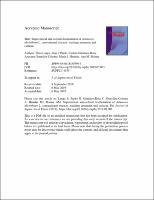Por favor, use este identificador para citar o enlazar este ítem:
https://repositorio.usj.es/handle/123456789/1059
Registro completo de metadatos
| Campo DC | Valor | Lengua/Idioma |
|---|---|---|
| dc.contributor.author | Langa Morales, Elisa | - |
| dc.contributor.author | Pardo, Juan Ignacio | - |
| dc.contributor.author | Gimenez-Rota, Carlota | - |
| dc.contributor.author | González-Coloma, Azucena | - |
| dc.contributor.author | Hernaiz, Maria J. | - |
| dc.contributor.author | Mainar, Ana M. | - |
| dc.date.accessioned | 2024-01-24T10:44:06Z | - |
| dc.date.available | 2024-01-24T10:44:06Z | - |
| dc.date.issued | 2019-09 | - |
| dc.identifier.citation | Langa E, Pardo JI, Gim´enez-Rota C, Gonz´alez-Coloma A, Hern´aiz MJ, Mainar AM, Supercritical anti-solvent fractionation of Artemisia absinthium L. conventional extracts: tracking artemetin and casticin, The Journal of Supercritical Fluids (2019), https://doi.org/10.1016/j.supflu.2019.05.003 | en_US |
| dc.identifier.issn | 1872-8162 | en_US |
| dc.identifier.uri | https://repositorio.usj.es/handle/123456789/1059 | - |
| dc.description.abstract | In the current work the Supercritical Anti-solvent Fractionation (SAF) methodology was applied to conventional extracts from Artemisia absinthium L. (wormwood). Artemetin and casticin, two compounds found in wormwood extracts and with high structural similarity, were tracked in all the experiments. A Response Surface Methodology (RSM), based on Central Composite Design (CCD) was used for both the experimental design and the results correlation. Studied variables were pressure (from 8.0 to 15.0 MPa) and CO2 flow rate (from 10 to 60 g·min-1), while temperature (40 0C) and feed solution flow rate (0.45 mL·min-1) were maintained constant. Overall achieved yields were around 70 %, being downstream vessel yields much higher than those in the precipitation vessel. The conditions predicted to reach an optimal overall yield and fractionation were 80 MPa and 10 g·min-1 (composite desirability = 0.7443). Casticin and artemetin were mainly obtained in the downstream vessel, being this fraction more enriched in artemetin than casticin. | en_US |
| dc.format.extent | 34 p. | en_US |
| dc.format.mimetype | application/pdf | en_US |
| dc.language.iso | eng | en_US |
| dc.publisher | Elsevier | en_US |
| dc.relation | The authors are grateful for the financial support of MINECO-FEDER (Project CTQ2015-64049-C3-2-R) and of Departamento de Innovacion, Investigacion y Universidad del Gobierno de Aragon-FEDER-FSE "Construyendo Europa desde Aragon" (Grupo E39_17R). | en_US |
| dc.rights | Attribution-NonCommercial-NoDerivatives 4.0 Internacional | * |
| dc.rights.uri | http://creativecommons.org/licenses/by-nc-nd/4.0/ | * |
| dc.subject | Artemisia absinthium | en_US |
| dc.subject | Artemetin | en_US |
| dc.subject | Casticin | en_US |
| dc.subject | Supercritical Anti-solvent Fractionation | en_US |
| dc.title | Supercritical anti-solvent fractionation of Artemisia absinthium L. conventional extracts: tracking artemetin and casticin (versión aceptada) | en_US |
| dc.type | journal article | es_ES |
| dc.relation.publisherversion | https://www.sciencedirect.com/science/article/abs/pii/S0896844618305904?via%3Dihub | en_US |
| dc.identifier.doi | https://doi.org/10.1016/j.supflu.2019.05.003 | en_US |
| dc.rights.accessRights | open access | es_ES |
| dc.type.hasVersion | AM | es_ES |
| Aparece en las colecciones: | Artículos de revistas | |
Ficheros en este ítem:
| Fichero | Descripción | Tamaño | Formato | |
|---|---|---|---|---|
| Supercritical anti-solvent fractionation of Artemisia Accepted version.pdf | 1,22 MB | Adobe PDF |  Visualizar/Abrir |
Este ítem está sujeto a una licencia Creative Commons Licencia Creative Commons

